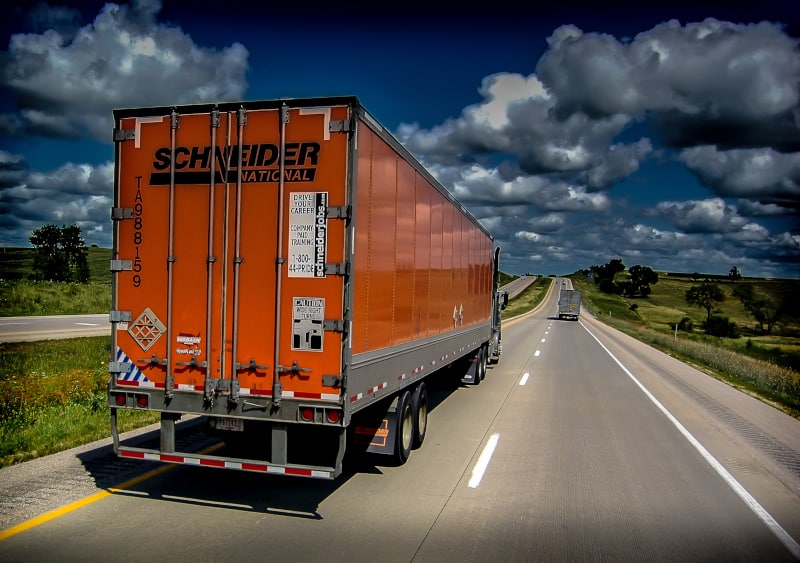
As Hurricane Florence approaches the southeast coast, many trucking fleets could be in the line of fire. Atlanta is a logistical hub, as is nearby Tennessee, which has been dubbed Freight Alley for the large amount of freight that moves through the region. It’s estimated that some 80% of the nation’s freight at some point in its journey moves through this region.
With so much freight in the area, it’s inevitable that truck equipment and facilities could be at risk. While the storm is forecast to come ashore in North Carolina and then drift south into South Carolina, its effects will be widespread. There are many major highways in the area that could be affected, including I-40, I-95, I-74, I-85, I-77 and I-81, and any vehicles traveling along those routes will be affected in some way.
So, how does a carrier protect its two largest investments – people and equipment – and still keep its operations running? Schneider National (NYSE: SNDR) has a Crisis Communication Team (CCT), and while that team is extremely busy this week, the company was kind enough to share some of the things it does and has learned over the years in preparing for major storms.
Planning starts 3 to 5 days ahead of an event, the company explains, with the first focus on low-lying areas. “We follow the tracking of the storm, road conditions and rainfall predictions to assist with our planning and decisions,” a Schneider spokesperson says. Those decisions include whether to relocate equipment. “There are a number of factors that we take into consideration when and if to relocate equipment: location of affected area, impact of the storm, amount of rain, amount of equipment that needs to be relocated, low-lying areas, etc.”
As planning gets underway, the primary objective is to ensure the safety of drivers out on the road, with equipment and customer freight also important.
“We are continuously monitoring the weather and road conditions so we can be proactive should anything arise,” the spokesperson says. “We have teams in place to provide 24/7 tracking of developments and will be in constant contact with our associates in affected areas to coordinate safety and communications plans. We have technology in our trucks that allow us to constantly track and communicate with our drivers.”
Staying in contact with drivers is important, and the CCT team works hard to keep the information flowing and shared with drivers. With that said, drivers are still out on the road in harm’s way, so Schneider tells its employees to maintain an emergency kit with enough supplies (food, money, clothes and medicine) for at least 72 hours.
The company has learned from past situations and fine-tuned its planning, which now focuses on three core areas: associate safety, freight movement and technology.
“Our expertise and support have been successful as we have worked through a variety of emergency situations in the past and are confident our planning will be successful should a weather-related crisis develop,” the spokesperson explains. “But the bottom line is this: Always be prepared by having a plan. Then in a disaster situation, follow that plan. Keep vigilant on the storm that may affect your organization. Proactively communicate with drivers, other associates and customers. And make sure your first priority is always to protect the safety of your associates and customers’ freight.”
Once equipment and people are safe, communication with customers is a core requirement.
The CCT team works to “synchronize/align communications between the associates and customers. In the days leading up to any hurricane making landfall, we will work with customers to prioritize loads and help move the highest priority freight out of harm’s way as quickly and safely as possible,” the spokesperson says. “Our technological backbone is a competitive advantage. All of our operations are networked and data is centralized to keep operations running smoothly. Should a hurricane or other disaster prevent operational support in an affected area, that data can be transferred and used by other associates in different regions within our network – the work can continue, assuring service can continue with minimal interruption.”
Schneider says that working with customers, government officials and vendors is important, but disruption is going to happen. “This depends on the amount of impact there is to the affected area,” the company explains. “Some of the bigger storms (e.g., Harvey) can cause longer disruption. However, we work with customers, government officials and vendors (railroads, third-party carriers) to re-route loads, stage inventory outside affected areas and move essential commodities into affected areas once it is safe to do so.”
Relationships with local agencies are important as the information can be critical for when to restore operations and to coordinate relief efforts, if necessary.
“We have strong relationships with local, state and federal agencies, and will work with those groups to support relief efforts and get back to normal operations as quickly as possible,” Schneider’s spokesperson notes.
As to what Schneider is expecting from Florence and its potential cost, that is not an easy number to calculate.
“This is difficult to answer because it depends on the severity of the storm, how large of an area is impacted and what area is affected,” the spokesperson says. “We have processes, procedures and technology in place that allows us to move workloads to other parts of our organization if our facilities are in the affected areas, which help minimize the impact. The bottom line is it comes down to working with local authorities and moving loads when it is safe to do so in the impacted areas.”







